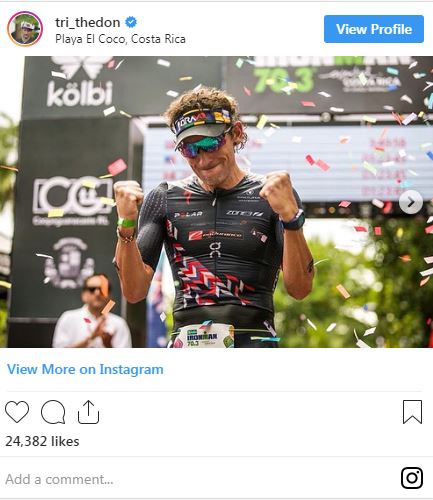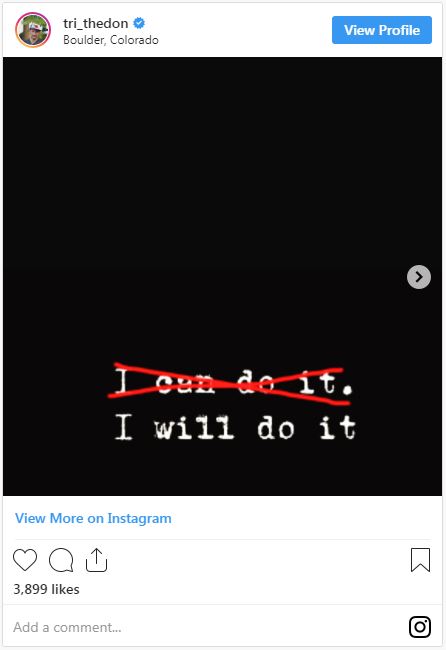Tim Don was the world’s fastest Ironman athlete when he broke his neck and had four titanium bolts screwed into his skull. Six months later he ran a 2:49 marathon. Here he reveals what it took.
It’s October 2017. Tim Don, the fastest Ironman athlete on the planet, is in Kona, Hawaii, ahead of the Ironman World Championship, when disaster strikes on a morning practice ride.A truck, either not seeing Tim or misjudging his speed, hits the British-born athlete. “I remember locking my rear wheels, putting my breaks on, just skidding, thinking, ‘Oh no, these are my brand new tyres!’ I came to in a heap on the ground 20-25 minutes later in excruciating pain in my shoulders and neck.”Unaware of the severity of his injuries (Tim initially thought he had whiplash and could possibly still race), it was only when it took eight nurses to lift him off the MRI table that he suspected the damage was serious. Eventually, the emergency doctor confirmed a broken neck, a C2 fracture. Then came the halo…

A circular metal framework which involves screwing four bolts into the skull, with a brace that reaches down to the tummy button and back, to stabilise the neck, the halo was the most painful and extreme option, but it came with an enticing statistic: a 90 per cent chance of 100 per cent recovery. The odds looked good to the three-time Olympian, who wasn’t ready to call time on a successful triathlon career. “I didn’t want to go out because of a careless driver. I would rather try and fail than never fail at all.”
The pain was immense. “To give you an idea, when you tighten up your bike seat post, the screws in my skull were tighter than that so they wouldn’t move. And I had four of them.”
I didn’t want to go out because of a careless driver. I would rather try and fail than never fail at all.
Tim DonSleeping became almost impossible. “Any kind of movement put extra pressure on the screws so I had to sleep bolt upright. In the first three weeks, the longest I slept in one stint was probably about 90 minutes.” Simple tasks, like showering and getting dressed, became a two-person job. “Kelly, my wife, had to give me sponge baths.” But the support from family and friends, and the urge to put on a brave face for his children, aged three and seven, helped act as a driver. “I thought, if I’m a miserable bugger, that’s just not cool for everyone who’s supported me, especially in that first month. All those things that people did for me, I guess they kept me going.
“Two months into wearing the Halo, the 40-year-old’s sponsors, running brand, On, offered him the chance to run the Boston Marathon, a milestone event that would mark six months since his injury. Incredibly, he ran it in 2:49.
But the best was yet to come. On June 25, 2018, Tim defied the odds once more, winning at Ironman 70.3 Costa Rica. Amazing doesn’t cover it.

Here, the athlete recalls the mental approaches that got him through the dark times and up and running again.
1. Never give up
After four or five days of wearing the halo, Tim’s drugs made him vomit. He recalls the painful experience: “When you throw-up you have that jerk of your neck, but for me there was no movement at all because of the screws in my head. It was pretty horrific. I almost went into the garage to get an allen key to remove the halo myself. What was the alternative? To buy a bottle of whiskey, sit in a dark room and feel sorry for myself? To wear the soft collar, have the fusion and end my professional career? I’ve been a professional athlete for 20 years and, as an athlete, you want to end your career on your terms.”
2. Focus on the process, not the goal
Tim broke down each day into small processes and achievements. “I’m a big believer on focusing on the process not the goal,” he says. Everyday tasks were a challenge. “Just making a coffee – if the milk was at the back of the fridge, I couldn’t reach it because I couldn’t get my head in there. If I had a doctor’s appointment, I couldn’t get my head in the car unless I crouched down and went in backwards. Because of the halo, we had to cut all my t-shirts like the guys you see at Venice Beach just to get them over my head!” Segmenting the day was a helpful strategy. “If I’d have focused on ‘I have two-and-a-half months left with this halo on’, I would have gone mad. Instead, I was like, ‘OK, get up. I’ll try and make Hugo’s breakfast this morning. Right, they’ve gone to school so I’m going to get the bathroom ready.’ I definitely broke the day down, absolutely.”
3. Allow yourself time to grieve – and then move forward
Missing out on what could have been the pinnacle race of your life is a massive blow. “If you can win Kona in our sport, it’s like winning Wimbledon. It’s a big deal and I was one of the favourites, if not the favourite to win. I’m 40 now, I’ve got maybe two or three years left at this level and I just kept thinking: ‘What if?’ about the race. But I knew that didn’t help the situation. It didn’t change anything. So then it was like, ‘Right, it’s happened. What are we going to do?’ I was definitely always trying to look forward.”
4. Look for the positives
“At first there were absolutely no positives,” says Tim. “I think it took three weeks and a few dark days but, once I was off the codeine-based medication, I started thinking I could get back. Bones heal. I was having scans every three weeks and doctors were happy with the curvature of my spine and the gaps between my vertebrae, which were crucial to keep that movement.”
5. Be adaptable
In the early stages of Tim’s recovery his limited mobility meant he couldn’t turn his head in the pool to breathe or use a standard turbo to train on. “In the beginning I swam with a special snorkel that goes directly between your nose, over your head. I had to start running on an anti-gravity treadmill. I had to change the position on my bike. We were working around the problem without creating other problems.”Tim would also err on the side of caution during training sessions. “If I felt I could do an hour and a half, I’d do 1h 15. I think that’s experience and a sensible side coming through. A little is good and often more is not better,” he says.
6. Find your motivation
Initially, thoughts of competing were the last thing on Tim’s mind. “I couldn’t comprehend swimming one length let alone imagine doing a whole Ironman in seven hours,” he says. But, within weeks, hopes of returning to triathlon became a driving force. “After about three-and-a-half weeks in the halo, I went to the gym and did five minutes on the exercise bike, very easy. And then I was like, hold on, if I can do five minutes today, I can do six minutes tomorrow, eight minutes, etc, so that when the halo comes off, I won’t be fit but my muscles will hopefully be ready for some training.” So Tim became a gym junkie. “Every day, I was in the gym for one-and-a-half to two hours, doing my warm-up on the bike, doing these very basic lower-leg and arm exercises. And that was the beginning of the driving force of: “OK, we can get back.”
7. Give your day purpose
For Tim, getting back into training was as important mentally as it was physically. “For the past 20 years I’ve been training for 30 hours a week with two weeks off, so returning to training made a massive difference to how I was feeling. It was a release. Obviously someone had to take me to the gym and pick me up afterwards, but I felt I had purpose again and it had a very positive effect on my mental state,” he explains.
8. Set a milestone goal

It was in December 2017 that On, Tim’s sponsor, approached him about running the Boston marathon, then four months away. “I thought yep, I’ll do that. If I can pin on a number that can be a good way for me to get back. For me, the ‘win’ would be getting round in a half-decent time without getting injured.”
In the end, Tim ran the marathon in a staggering 2:49:42, six months and three days after his neck-breaking crash. It became a milestone and, mentally, flicked a switch in his approach to his training. “The last six months have been all about recovery, and I’m still very much focused on recovery, but when the gun goes in a race in six months’ time, people aren’t going to care about my story as long as they beat me. Now, I need to get physically stronger and faster. I need to swim 5km a day, I need to ride, I need to run. Now I feel I’m really training.”
